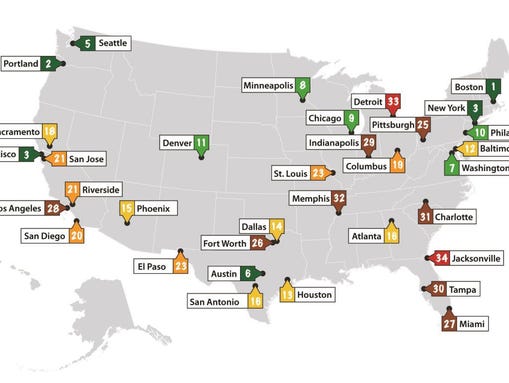While Congress dithers on energy efficiency, cities are moving ahead with energy-saving steps such as bike-sharing, tougher building codes, electric vehicle charging stations and cool roofs, says a study out Tuesday that ranks 34 major U.S. cities, According to USAToday.
Boston takes first place for its efforts to reduce energy use, followed by Portland, Ore., New York City, San Francisco, Seattle and Austin, according to the first-ever scorecard by the American Council for an Energy-Efficient Economy (ACEEE), a Washington-based research group.
What’s exciting is the quickening pace of these efforts, says lead author Eric Mackres. “Over the past five or so years, cities are rediscovering how important energy efficiency is to their economies,” he says, adding that federal Recovery Act funds helped them test potential solutions — some of which have since been adopted.
Capitol Hill is another story. Congress remains stalled on a bipartisan, cost-neutral bill that offers financial incentives, worker training, expert advice and other tools to help businesses adopt energy-efficient technologies. The bill passed a Senate committee earlier this year but is now stuck on the Senate floor, because lawmakers have attached controversial amendments that have nothing to do with energy efficiency.

Cities have picked up the slack. More are requiring buildings to disclose energy use so prospective renters can anticipate utility costs, helping low-income households make efficiency retrofits so they save money and toughening building codes so less energy is used.
More than a dozen cities have launched bike-sharing programs and about two dozen — including Atlanta, Houston and San Antonio — have installed EV charging stations in public areas. New York City, Houston and Chicago have each launched programs to plant 1 million trees citywide. At least 10 — including Dallas, Miami and Philadelphia — have policies to promote or require “cool roofs” to reduce how much solar heat a building absorbs.
The ACEEE scored the cities for their efforts in five areas: buildings, transportation, energy and water utility programs, local government operations and community-wide initiatives. While Boston got the highest overall score of 77, out of a maximum 100, Portland did best in transportation, Seattle in building policies and San Francisco (along with Boston) in utility benefit programs.
In its Renew Boston effort, Boston has partnered with investor-owned utilities to tell consumers about rate-payer financed incentives for buying energy-efficient appliances and making energy-saving retrofits.
“Environmental development goes hand in hand with economic development,” Boston Mayor Thomas Menino said at a press briefing on the scorecard. He says both benefit city residents, although officials need to learn “street” rather than “scientific” talk to help them understand how.
“Both business and the public are with us,” Portland Mayor Charlie Hales told reporters, adding they realize that energy efficiency is good for the environment as well as the bottom line.
The second-highest-scoring tier of cities, earning between 53 and 56 points, includes Washington, D.C., Minneapolis, Chicago, Philadelphia and Denver. The lowest-scoring cities were Detroit (19 points) and Jacksonville (17 points).
“All cities, even the highest scorers, have significant room for improvement,” the report says. Mackres says it ranked cities on their efforts rather than actual energy use, because data on the latter is incomplete and climate differences can affect how much energy cities use.
How U.S. cities rank on energy efficiency efforts
Rank..City……….Total score (Maximum 100)
1……Boston, MA…………….76.75
2……Portland,OR………….70.00
3……New York City………..69.75
3…..San Francisco, CA…. 69.75
5…..Seattle, WA…………… 65.25
6.. ..Austin, TX……………… 62.00
7…..Washington, DC…….56.00
8…..Minneapolis, MN……..55.25
9…..Chicago, IL………………54.75
10..Philadelphia, PA……. 54.50
11..Denver, CO……………. 52.75
12..Baltimore, MD…………46.50
13.Houston, TX……………. 45.25
14..Dallas, TX……………….44.25
15..Phoenix, AZ…………….43.50
16..Atlanta, GA…………….. 42.50
16..San Antonio, TX…….. 42.50
18..Sacramento, CA……. 40.75
19..Columbus, OH……… .38.50
20..San Diego, CA……….. 38.25
21..Riverside, CA…………. 37.25
21..San Jose, CA…………. 37.25
23..El Paso, TX……………. .36.25
23..St. Louis, MO……………36.25
25.. Pittsburgh, PA………. .34.25
26.. Fort Worth, TX………. .32.75
27.. Miami, FL……………… .32.00
28.. Los Angeles, CA……. 31.50
29.. Indianapolis, IN…….. .28.25
30.. Tampa, FL…………….. .26.75
31..Charlotte, NC…………. .23.75
32..Memphis, TN……………23.50
33..Detroit, MI………………. .19.00
34.. Jacksonville, FL………17.25

